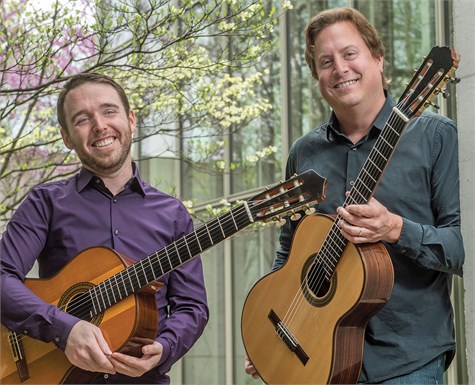by Daniel Hathaway

Davin will play the Cello Suite No. 6 in D, BWV 1012, and the Violin Partita No. 2 in d, BWV 1004. Vieaux has chosen the Violin Sonata No. 1 in g, BWV 1001, and the Cello Suite No. 1 in G, BWV 1007. You can join the event here for a donation of $10.
I caught up with Vieaux and Davin for a Zoom conversation on Monday afternoon and started by asking them how they had decided on an all-Bach program for next Saturday.
Davin: It was sort of our idea, but Armin Kelly was readily enthusiastic about it. We had talked about another program right after we finished the one in June, and I think I might have suggested all-Bach.
Vieaux: You did.
Davin: We thought that two suites each would make a nice program.
Vieaux: By June 6 we were already three months into this quasi-isolation, pandemic thing, and preparing a half hour of music and sharing a program with a great guitarist seemed like getting a whole concert together. I’ve been practicing three different Bach suites over the last two months trying to decide what to play, and that was just wonderful. It felt like being a musician again.
Hathaway: When did each of you start playing Bach during your careers?
Vieaux: My first pieces were the Bourée and Allemande from the Third Cello Suite in the mid-80s in the Duarte edition. The Australian guitarist John Williams made an early recording of them.
Davin: The first Bach I remember learning was one of the Gavottes from the Sixth Cello Suite — which I’m playing on Saturday. That must have been in middle school. Then the first suite I learned when I was in high school — probably studying with you, Jason — was the Third Lute Suite. Whether or not I have a performance of Bach coming up, it’s always good to be thinking about that music. It enhances how I play other repertoire.
Vieaux: Bach’s music has this very wholesome, cleansing feeling to it. The only time I practiced three suites simultaneously was about four years ago when I was getting ready for a recital at the Arizona Bach Festival. If I could make a living just playing Bach all the time, it would be great for my playing and I’d never get tired of it. There’s very little music that substantial, that keeps delivering the goods over and over again. And the discovery of details never seems to end.
Davin: I’ve surprised myself in both a good way and a bad way while playing Bach in a recital. ‘Oh, I just had an idea. I could ornament a line this way…’
Jason: (laughing) OK, we’ll deal with that later.
We took a little detour into talking about Bach’s lute suites, which are really for a keyboard instrument — the Lautenwerk — and don’t adapt themselves so well to the guitar. Davin said that the violin suites, on the other hand, work very well, and Vieaux noted that when you play them from the violin part, they sound an octave lower, which fits very nicely into the guitar’s natural speaking voice.
Hathaway: How did you split up the repertoire for this program?
Davin: We happened to have two different sets of Bach pieces that are fresh in our repertoire. It’s great when you’re programming that you find works that you love that fit together. Of course, three of the four pieces are in D Major or Minor.
Vieaux: Maybe I’ll tune my guitar up a half step to give people’s ears a little break.
Hathaway: And one of Colin’s key-of-D pieces contains the famous Chaconne. What does it feel like being in the middle of that work?
Davin: It’s an incredible experience. Since I started playing that piece, I play through it a few times a week whether or not it’s going to come up on a program. It has most of the technical demands that you can envision having in a piece, and it’s sublime music. Sometimes I’m tempted to bask in it — stretch things out and luxuriate — but it’s a continuous, dance-based variation form that’s constantly in motion. And I love putting it into the context of the whole Partita. There’s so much structural unity across the five movements that culminates in the Chaconne.
Hathaway: Jason, do you have a favorite movement or piece in this program?
Vieaux: I’ve been enjoying playing the Cello Suite. It’s a little lighter on the hands than the Violin Sonata — it loosens me up a lot. I’ve been going in that direction in my Bach playing, letting things breathe or letting them speak. Letting juicier harmonies speak for a few milliseconds without losing the general flow of the music or the architecture of the fugue. But the Fugue of BWV 1001, that’s really my favorite. With Bach, it’s really a matter of how many nutrients you want to get across to the listener.
This led to a complicated discussion about fugues and fingering which is best left to guitarists.
Hathaway: Anyway, I’m sure you’ll make those fugues look effortless.
Davin: But I don’t have any fugues to play!
Vieaux: Like the Second Partita’s a walk in the park!
Hathaway: Will you end the program by playing anything together?
The two traded conspiratorial smiles.
Published on ClevelandClassical.com November 10, 2020
Click here for a printable copy of this article



